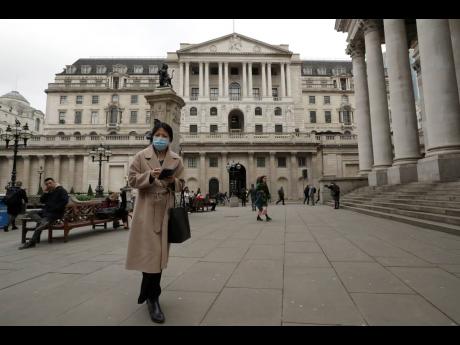Bank of England eyes sub-zero rates in face of virus, Brexit
The Bank of England indicated Thursday that it could cut interest rates below zero for the first time in its 326-year history as it tries to shore up a UK economic recovery that is facing the dual headwinds of the coronavirus and Brexit.
After unanimously deciding to maintain the bank’s main interest rate at the record low of 0.1 per cent, the nine-member rate-setting Monetary Policy Committee said it had discussed its “policy toolkit, and the effectiveness of negative policy rates in particular”.
In minutes accompanying the decision, the rate-setters said a recent wave of virus infections has “the potential to weigh further on economic activity, albeit probably on a lesser scale than seen earlier in the year”.
Though the committee noted that recent economic data have been a “little stronger than expected” at its last meeting in early August, it said it is unclear what that says about the future, “given the risks”.
One clear concern relates to whether Britain, like others in Europe, will reimpose broad restrictions on businesses and public life after the recent flare-up in virus infections across the region. Already, social gatherings are being restricted and certain areas of the United Kingdom, UK, are seeing localised lockdowns.
The British economy suffered one of the deepest recessions in the world this year when many sectors were effectively mothballed to help contain the pandemic. Though it recouped some ground in the summer as lockdown restrictions were eased, the economy was still around 12 per cent smaller at the end of July than it was in February, when the pandemic started in Europe.
The other major risk facing the UK economy relates to the post-Brexit trade discussions between the UK and the European Union following a worsening in relations. If the talks collapse, tariffs and other impediments to trade will be imposed by both sides at the start of 2021, a development that would hurt the UK more.
The UK left the EU on January 31, but is in a transition period that effectively sees it benefit from the bloc’s tariff-free trade until the end of the year while the future relationship is negotiated.
With the outlook so murky, the bank was not expected to provide more stimulus on Thursday. Since the pandemic started, it has cut its main rate to a record low and boosted its bond-buying programme to make sure financial markets don’t get clogged up and keep borrowing affordable.
The policymaking panel said Thursday it could take further action on borrowing costs after revealing it had been briefed on how to effectively implement negative interest rates, which would seek to encourage banks to lend rather than hoard their cash. The central bank will further discuss the potential use of negative rates during the fourth quarter.
Though that doesn’t necessarily mean a rate cut is likely this fall, it’s a clear signal that the bank could enact further stimulus measures.
“While the bank is clearly exploring the possibility of using negative rates as a potential tool, we doubt it will go down that path anytime soon — at any rate, not in November,” said Kallum Pickering, senior economist at Berenberg Bank.
Still, financial markets interpreted the announcement as increasing the likelihood of negative rates next year, potentially in the event of the UK and the EU failing to agree on a trade deal. The pound fell 0.7 per cent to US$1.2884.
Most economists think the bank will boost its bond-buying stimulus programme in November. By then, unemployment across the UK is expected to be rising sharply as a government salary-support programme will have come to an end.
The Job Retention Scheme, under which the government pays the bulk of the salaries of workers that firms keep on rather than fire, has kept a lid on unemployment. However, it ends on October 31, a change that most economists think will more or less double the UK’s unemployment to around 8 per cent from 4.1 per cent at present.
AP

